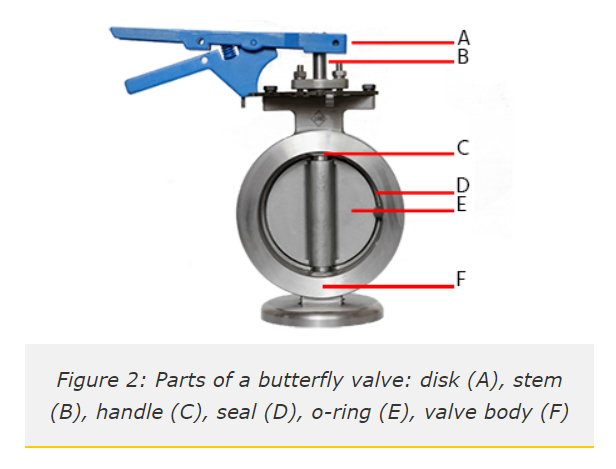Butterfly Valve - How They Work
2023-12-26
Butterfly valves are quarter-turn valves that are popular for on-off or modulating services. They are lightweight, have a small installation footprint, lower cost, quick operation, and are available with large orifice sizes. The “butterfly is a disk connected to a rod. When the valve opens, the disk rotates to allow fluid to pass through. It closes when the rod rotates the disc by a quarter turn to a position perpendicular to the flow direction. Learn more about how butterfly valves work and when to use them for different applications.
Principle of operationButterfly valves have a relatively simple construction. Figure 2 shows the main components of a butterfly valve, which are the body, seal, disc, and stem. The disc (Figure 2 labeled E) of a butterfly valve aligns with the center of the connected piping and the stem (Figure 2 labeled B) connects to an actuator or handle on the outside of the valve. In the closed position, the disc is perpendicular to the flow, as shown in Figure 2, and seals against the valve seat (Figure 2 labeled D). An o-ring (Figure 2 labeled C) in the stem packing seals against leakage along the stem. When the actuator or handle rotates the butterfly valve stem 90°, the disc also rotates 90° to become parallel to the flow. Partial rotation allows for the flow to be throttled or proportional.

Disc closure designButterfly valves can be concentric or eccentric depending on the location of the stem in relation to the disc’s centerline and the surface angle of the valve seat.ConcentricThe most basic design of a butterfly valve is a centric or concentric butterfly valve. The stem passes through the disc’s centerline, and the seat is the inside diameter periphery of the valve body (Figure 4 on the left). This zero-offset valve design is known as resilient-seated because efficient sealing relies on the flexibility of the rubber seat. When closing, the disc first comes into contact with the seat at around 85° during a 90° rotation. Concentric butterfly valves are suitable for low-pressure ranges.
EccentricAn eccentric butterfly valve’s stem does not pass through the centerline of the disc but instead behind it (opposite of flow direction), as seen in Figure 4 (right). A single offset butterfly valve’s stem is directly behind the disc’s centerline. This design reduces how much the disc contacts with the seal before the valve fully closes. Less contact improves the service life of the valve.
In a double offset or doubly eccentric butterfly valve, the stem is behind the disc’s centerline with an additional offset to one side (Figure 5). The stem’s double eccentricity design reduces disc and seat contact to the last 1-3° of disc closure.
A triple offset butterfly valve (TOV or TOBV) is suitable for critical applications and has a similar design to a double offset butterfly valve. The third offset is the disc-seat contact axis. The seat surface has a conical shape which, coupled with the same shape at the ridge of the disc, results in minimal contact before full closure of the valve. A triple offset butterfly valve is more efficient and experiences less wear. Triple offset valves are often made of metal seats for a bubble-tight shut-off. The metal seats make butterfly valves suitable for higher temperature ranges.
High-performance butterfly valves use the pressure in the pipeline to increase the seal between the seat and the disc edge. These butterfly valves have higher pressure ratings and are prone to less wear.



